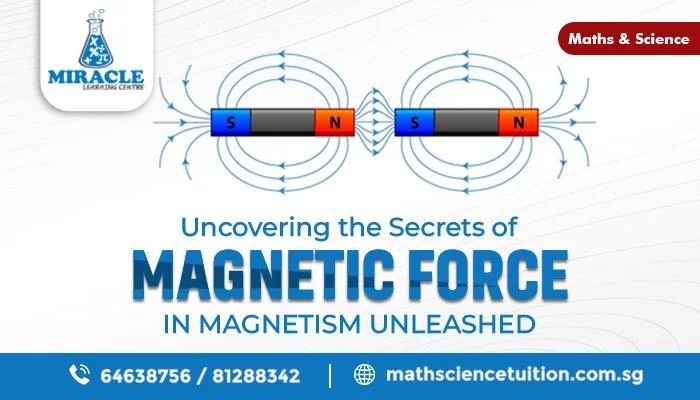A key feature of the natural world is magnetism, a fascinating force that has captivated mankind for generations. It includes the characteristics and behaviours of magnets and magnetic materials, influencing them through the interplay of moving electric charges. At Miracle Learning Centre, we embrace the wonders of magnetism and its profound influence on our lives. As a renowned science tuition centre, our mission is to delve deep into the essence of magnetism, unravelling its intricacies and shedding light on the enigmatic magnetic fields and magnetic force.
Through this post, we will explore the intriguing concept of magnetism, uncover the secrets of magnetic fields, and delve into the fascinating world of magnetic force. By understanding the principles and applications of magnetism, we can appreciate its significance in various fields, from technology to medical diagnostics.
So, let's embark on a journey to unravel the wonders of magnetism and discover the magnetic forces that shape our world.
What is Magnetism?
Magnetism is a natural phenomenon characterized by the force exerted between magnets or magnetic materials. It arises from the movement of electric charges, such as the flow of electrons. When a magnet interacts with a magnetic material, like iron, it can induce magnetization in that material, causing it to be attracted to the magnet. When a magnet comes close to a piece of iron, the iron becomes magnetized and is drawn towards the magnet.
This intriguing property has fascinated humans for centuries and has led to numerous practical applications. It is the backbone of magnetic storage devices such as hard drives and magnetic tapes, where information is stored as magnetic patterns. Electric motors and generators utilize magnetism to convert electrical energy into mechanical energy and vice versa. Magnetic levitation technology, known as maglev, allows objects like trains to glide smoothly above their tracks using repulsive magnetic forces.
Applications of Magnetism:
Magnetism has a wide range of practical applications that have revolutionized various industries. From information storage to transportation, magnetism plays a crucial role in enhancing our lives.
Let's explore some of the most significant applications of magnetism:
Magnetic Storage Devices:
Magnetism is at the heart of modern data storage technology. Hard disk drives (HDDs), floppy disks, and magnetic tapes utilize magnetic fields to store and retrieve vast amounts of digital information. In these devices, data is encoded as binary information and magnetically stored as tiny magnetic regions on the storage medium's surface. The read/write heads of the devices use magnetic fields to read or write data by detecting the changes in magnetization.
Electric Motors and Generators:
Electric motors and generators are essential components in countless devices and industries. They rely on the interaction between magnetic fields and electric currents to convert electrical energy into mechanical energy (motors) or vice versa (generators). In electric motors, an electric current passing through a coil placed in a magnetic field generates a force that produces rotational motion. Generators, on the other hand, use mechanical energy to rotate a coil within a magnetic field, generating an electric current.
Magnetic Levitation:
Magnetic levitation, or maglev, is an innovative technology that uses magnetic fields to suspend objects, particularly trains, above their tracks. By exploiting the repulsive force between magnets, maglev trains can glide smoothly and efficiently without any physical contact with the tracks. This reduces friction, noise, and wear, allowing for high-speed transportation. Maglev trains have achieved impressive speeds, surpassing traditional trains and offering a promising future for transportation systems.
Magnetic Resonance Imaging (MRI) Machines:
MRI machines have transformed medical diagnostics by providing detailed images of the human body's internal structures. They utilize powerful magnetic fields and radio waves to create images that help diagnose a wide range of conditions. In an MRI machine, a patient is placed in a strong magnetic field that aligns the protons in their body. When radio waves are applied, the protons emit signals that are detected and processed to generate detailed images. MRI is a non-invasive, safe, and highly valuable tool for diagnosing various diseases and injuries.
Magnetic Sensors:
Magnetic sensors are widely used in various applications, including navigation systems, robotics, and automotive industries. They can detect changes in magnetic fields and convert them into electrical signals. Magnetic sensors are used in compasses for navigation, proximity sensors in devices that require detecting the presence or absence of magnetic materials, and speed sensors in vehicles to measure the rotational speed of wheels and engines.
Magnetic Separation:
Magnetic separation is a technique used in many industries to separate magnetic materials from non-magnetic ones. It finds applications in areas such as mineral processing, recycling, and waste management. By applying magnetic fields to a mixture of materials, magnetic particles can be selectively attracted and separated from the rest, simplifying the separation process and improving efficiency.
Speakers and Headphones:
Speakers and headphones rely on magnets and electromagnets to produce sound. In speakers, an electric current passes through a wire coil attached to a diaphragm. The coil interacts with a permanent magnet, causing the diaphragm to vibrate and produce sound waves. Similarly, in headphones, electromagnetic drivers convert electrical signals into sound by creating varying magnetic fields that move the diaphragm and produce sound.
At Miracle Learning Centre, our teachers provide exceptional science tuition in Singapore. We understand the significance of magnetism in various fields, from data storage to medical diagnostics. Our experienced science teachers guide students in understanding the complexities of magnetism and its applications, fostering a deeper appreciation for this fascinating phenomenon.
Types of Magnetism:
Magnetism manifests in various forms, and different materials exhibit distinct magnetic properties. Here are the four main types of magnetism:
- Paramagnetism:
Paramagnetic materials display a weak attraction to magnetic fields and only exhibit magnetic properties when subjected to an external magnetic field. The magnetic moments of the atoms or molecules in these materials align with the field, but the alignment is temporary and disappears when the field is removed. Common paramagnetic substances include aluminum, oxygen, and platinum. While the magnetic effects of paramagnetic materials are relatively weak, they still play essential roles in applications like magnetic resonance imaging (MRI) and magnetic data storage.
- Ferromagnetism:
Ferromagnetic materials, such as iron, nickel, and cobalt, are characterized by their strong attraction to magnetic fields. They possess spontaneous magnetization, meaning they retain their magnetic properties even after the external field is removed. The alignment of atomic magnetic moments within these materials creates a strong collective magnetic field. Ferromagnets find applications in a wide range of devices, including electric motors, transformers, and magnetic recording media like hard drives.
- Antiferromagnetism:
In antiferromagnetic materials, adjacent atomic magnetic moments align in opposite directions, resulting in a cancellation of their magnetic effects at a macroscopic level. As a result, antiferromagnetic substances do not exhibit a net magnetic field. Chromium and manganese oxide are common examples of antiferromagnetic materials. Although they lack a macroscopic magnetic field, antiferromagnets have interesting applications in spintronics and magnetic storage technologies.
- Ferrimagnetism:
Ferrimagnetic materials, such as magnetite (Fe3O4), possess a combination of ferromagnetism and antiferromagnetism. The opposing alignment of atomic magnetic moments creates a net magnetization, albeit smaller than in ferromagnetic materials. This uneven alignment leads to a magnetic imbalance, resulting in a magnetic field. Ferrimagnetic substances are employed in applications like magnetic memory devices and microwave devices.
By comprehending the different types of magnetism, scientists and engineers can utilize these properties to create innovative technologies and advance various fields of study. At Miracle Learning Centre, our science tuition equips students with a deep understanding of magnetism's intricacies. Our dedicated teachers foster a strong foundation in this subject, enabling students to excel in their scientific pursuits.
What is Magnetic Force?
Magnetic force is the fundamental force that exists between magnets and magnetic materials in the presence of a magnetic field. It is responsible for the attractive or repulsive interaction between magnets. When magnets are brought close together, the magnetic force causes them to either attract (opposite poles) or repel (like poles) each other. The strength of the magnetic force depends on the distance between the magnets and their magnetic properties. This force is the driving factor behind the movement and behavior of magnets in various applications, from the operation of electric motors to the functionality of magnetic levitation systems.
What is Magnetic Field?
A magnetic field is a region in which a magnetic force can be detected. It is created by magnets or moving electric charges. A magnetic field has both magnitude and direction, and it can be represented by magnetic field lines. These lines provide a visual representation of the field's direction and intensity. Magnetic fields exist around permanent magnets, electromagnets, and current-carrying conductors. They can also be found on a larger scale, such as the Earth's magnetic field. Magnetic fields play a crucial role in various applications, from guiding charged particles in particle accelerators to enabling the operation of devices like electric motors and generators.
Some Interesting Facts about Magnetic Fields and Magnetic Force:
- The Earth's magnetic field acts as a shield, protecting us from harmful solar radiation and cosmic rays. Without it, life as we know it would be significantly different.
- Magnetic fields can cause interesting effects on everyday objects. For example, if you place a strong magnet near a television or computer monitor, it can distort the image or even permanently damage the screen.
- Magnetic fields play a crucial role in generating the spectacular phenomenon known as the Northern Lights (Aurora Borealis) and the Southern Lights (Aurora Australis). These mesmerizing displays occur when charged particles from the Sun interact with the Earth's magnetic field and create colorful light patterns in the atmosphere.
- In 1820, Danish physicist Hans Christian Ørsted accidentally discovered the connection between electricity and magnetism. While conducting a lecture demonstration, he noticed that a compass needle deflected when placed near a wire carrying an electric current. This groundbreaking discovery laid the foundation for the field of electromagnetism.
- The largest magnet in the world is the Large Hadron Collider (LHC) at CERN, the European Organization for Nuclear Research. It uses powerful superconducting electromagnets to accelerate and guide particles for high-energy collisions, allowing scientists to study the fundamental properties of matter.
- Magnetic resonance imaging (MRI) has revolutionized medical diagnostics. Unlike X-rays, which use ionizing radiation, MRI uses powerful magnetic fields and radio waves to create detailed images of the body's internal structures. It is a safe and non-invasive technique widely used to diagnose various conditions and injuries.
- Magnets have been used for healing purposes since ancient times. Some people believe that wearing magnetic bracelets or using magnetic therapy can alleviate pain and improve blood circulation. While scientific studies on the effectiveness of such therapies are inconclusive, the fascination with magnetic healing persists.
- Magnetars, a type of neutron star with incredibly strong magnetic fields, are among the most mysterious and extreme objects in the universe. Their magnetic fields are so intense that they can distort the structure of atoms and generate powerful bursts of radiation.
These captivating facts about magnetic fields and magnetic force truly highlight the vast influence and captivating nature of magnetism in our world and beyond. At Miracle Learning Centre, we understand the significance of this fascinating subject, which is why our dedicated team of science teachers in Singapore is committed to providing exceptional science tuition.
Through our science tuition, we aim to nurture the curiosity and understanding of students, enabling them to delve deeper into the wonders of magnetism. Our experienced science teachers in Singapore guide students through engaging lessons, helping them grasp the intricacies of magnetic fields and magnetic force. We believe that by exploring this captivating field, students can unlock a world of possibilities and pave the way for future discoveries.
Whether it's the applications of magnetism in magnetic storage devices, electric motors, or magnetic levitation, our science tuition offers a comprehensive learning experience. Our science teachers in Singapore utilize interactive teaching methods, making the learning process informative and enjoyable. We encourage students to ask questions, engage in discussions, and explore real-life examples, ensuring a holistic understanding of magnetism.
Miracle Learning Centre is more than just a tuition center; it is a place where students can ignite their passion for science and embrace the wonders of the natural world. Our science tuition instills a love for learning, fostering critical thinking skills and scientific inquiry. We believe that by nurturing the next generation of curious minds, we contribute to the advancement of scientific knowledge and innovation.
If you're seeking quality science tuition in Singapore, look no further than Miracle Learning Centre. Our dedicated science teachers are committed to empowering students, equipping them with the knowledge and skills necessary to excel in their academic pursuits. Join us on this captivating journey of discovery and unlock the potential within you. Enroll in our science tuition at Miracle Learning Centre and embark on a remarkable educational experience.








